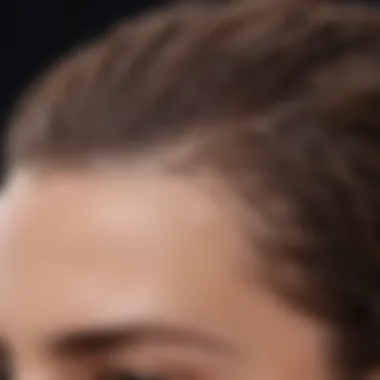Effective Strategies for a Thicker Hairline


Intro
A thicker hairline is a desire that resonates with many individuals, particularly in a time when beauty standards can often dictate one’s self-esteem. Hair thinning can significantly impact how one feels in their own skin. Therefore, understanding the potential strategies is crucial. This section will delve into the underlying causes of hair thinning while equipping readers with practical solutions to combat this prevalent concern.
Our hair naturally goes through cycles of growth, rest, and shedding. Various factors can disrupt this cycle, leading to thinning hair. Hormonal changes, nutritional deficiencies, and environmental influences can all contribute. Furthermore, stress and underlying health conditions may exacerbate these issues. Unpacking these elements will provide a clearer perspective on how they can be addressed.
Implementing effective strategies can restore not only the thickness of hair but also the confidence of those affected. This article aims to offer detailed insights into different approaches, from lifestyle adjustments to exploring medical treatments. Along the journey, practical tips will also be shared to promote overall healthier hair management.
Ultimately, this guide is crafted for women of all ages who seek improved hair health. With the right information, informed decisions become simpler. Let's explore the strategies that can lead you toward a thicker hairline.
Understanding Hair Thinning
Understanding hair thinning is crucial for anyone seeking to improve their hair health. Hair thinning can be a distressing condition, affecting individuals emotionally and psychologically. Recognizing the nuances of this issue allows one to make informed decisions about treatment options. Furthermore, awareness of the factors contributing to hair thinning can aid in developing effective strategies to restore hair thickness.
The Anatomy of Hair
To grasp how hair thinning occurs, it's important to comprehend the structure of hair itself. Each hair strand consists of three main parts: the cuticle, cortex, and medulla. The cuticle is the outermost layer, serving as a protective shield. Beneath this lies the cortex, which provides strength and color. Finally, the medulla, while present in some hairs, is a cellular core that may not have as significant a role in hair thickness.
The roots of hair are enveloped by the hair follicle, which plays a pivotal role in growth. Hair follicles beneath the scalp produce new hair and maintain existing strands. A healthy follicle is fundamental for promoting thickness and preventing hair loss. Thus, understanding this anatomy offers insight into the maintenance and care of hair.
Common Causes of Hair Thinning
Various factors contribute to hair thinning. Genetics is a primary factor, often resulting in patterns of hair loss that can be inherited. Hormonal changes, particularly due to pregnancy, menopause, or thyroid issues, often lead to temporary or permanent thinning. Additionally, certain medical conditions, like alopecia areata or scalp infections, can directly impact hair health.
Lifestyle choices have significant effects too. Poor nutrition, particularly deficiencies in iron, protein, and other essential nutrients, can weaken hair. Harsh hair care products or excessive heat styling also cause damage. Chronic stress is another often overlooked element, leading to hair shedding.
Awareness of these causes provides a foundation for addressing the issue effectively. Identifying the underlying reason behind one's hair thinning will guide the selection of appropriate treatment methods.
Identifying Your Hair Type
Knowing your hair type is essential when considering strategies for thickness. Hair types are generally classified into four categories: straight, wavy, curly, and coily. Each type varies in porosity, thickness, and curl pattern, which in turn affects how products and treatments interact with your hair.
Identifying whether your hair is fine, medium, or coarse is also crucial. Fine hair may require lighter products, while coarse hair often benefits from more nourishing options. Regularly assessing your hair condition, such as its moisture retention and resilience against styling, will help tailor care and treatment needs effectively.
In summary, understanding hair thinning is a multidimensional endeavor. By delving into the anatomy of hair, recognizing common causes, and identifying one's hair type, individuals can craft a more effective approach to restore their hair’s fullness and overall health. This groundwork is vital for any following strategies focused on achieving a thicker hairline.
Lifestyle Adjustments for Thicker Hair
Lifestyle adjustments play a crucial role in promoting thicker hair. Many factors influence hair health, and simple daily choices may lead to significant improvements over time. Nutrition, hydration, and stress management are all essential components that can affect hair growth and thickness. By adopting certain practices in these areas, individuals may not only enhance their hairline but also improve their overall well-being.
Nutrition and Diet
A balanced diet is vital for hair growth. Nutrients such as proteins, vitamins, and minerals are necessary for healthy hair. Proteins are the building blocks of hair. A diet rich in lean meats, eggs, fish, and legumes can provide essential amino acids. Incorporating foods high in omega-3 fatty acids, like salmon and walnuts, also promotes scalp health. Vegetables and fruits rich in vitamins A, C, and E support healthy hair follicles.
Key nutrients include:
- Biotin: Found in eggs and nuts, biotin enhances hair strength.
- Zinc: Present in shellfish and seeds, zinc helps repair tissue and keeps hair follicles functioning properly.
- Iron: Leafy greens and cereals provide iron, which is important for proper blood circulation.
A nutrient-rich diet not only fosters hair growth but also boosts immunity and energy levels, making it a win-win for overall health.
Hydration Importance
Staying hydrated is often overlooked in hair care discussions. Water is essential for transporting nutrients throughout the body, including the scalp. Dehydration may lead to dry and brittle hair, which is more likely to break.
Consider the following tips for maintaining proper hydration:
- Aim for at least eight cups of water daily.
- Include hydrating foods, such as cucumbers and oranges, in your diet.
- Limit caffeine and alcohol intake, as they can dehydrate the body.
Maintaining adequate hydration levels can significantly improve hair texture and promote a healthy scalp.
Stress Management Techniques


Stress impacts hair health in profound ways. Research has shown that high-stress levels can lead to hair loss and thinning. Finding effective stress management techniques is essential for maintaining a thick hairline.
Some strategies might include:
- Mindfulness meditation: Practicing mindfulness can reduce stress levels and promote relaxation.
- Physical activity: Regular exercise releases endorphins, which improve mood and reduce anxiety.
- Adequate sleep: Ensuring sufficient sleep allows the body to recover and rejuvenate.
By managing stress, individuals can potentially reduce the risk of hair thinning and promote a healthier scalp for more robust hair.
Living a balanced life with attention to diet, hydration, and stress management can profoundly impact hair health.
Hair Care Practices
Hair care practices play a significant role in achieving a thicker hairline. Many women overlook the impact of daily routines on hair health. By understanding and implementing the right practices, it is possible to promote thicker and healthier hair. This encompasses various aspects, including the choice of products, heat management, and stimulation techniques.
Choosing the Right Shampoo and Conditioner
Selecting the appropriate shampoo and conditioner is crucial. A well-formulated shampoo not only cleanses the hair but also preserves natural oils. Look for sulfate-free options as sulfates can strip the hair of essential moisture, leading to dryness and breakage. Natural ingredients like aloe vera and coconut oil can benefit your hair significantly.
In terms of conditioners, they should provide moisture and fortify the hair. Choose protein-rich conditioners that help to strengthen the hair shaft. Remember, different hair types require specific formulations. If you have fine hair, a volumizing conditioner may be beneficial, while thicker hair might need deeper hydration.
Heat Protection and Styling Tools
Using heat styling tools can damage hair if proper precautions are not taken. Always apply a heat protectant spray prior to using tools like hair dryers, straighteners, or curling irons. This creates a barrier that limits damage from high temperatures. Look for heat protectants containing silicones, as they can effectively shield the hair.
Limit the use of heat styling tools as much as possible. Consider different styles that require minimal heat. For example, braiding damp hair overnight can create waves without the heat damage. Selecting tools with adjustable temperature settings can also help you manage the heat exposure, thus preventing unwanted breakage.
Scalp Massages and Their Benefits
Regular scalp massages offer numerous benefits for hair health. These massages improve blood circulation in the scalp, which nourishes hair follicles. There is also evidence that it can help reduce stress levels, contributing to overall hair vitality. You can use natural oils like jojoba or rosemary oil, which are known to support hair growth.
To perform a massage, use your fingertips to apply gentle pressure in circular motions. This should be done for about 5-10 minutes a few times a week. The process not only relaxes the scalp but may also promote thicker hair over time. Massages can also help in eliminating buildup that clogs hair follicles, facilitating better hair growth.
"Healthy hair starts at the roots. Paying attention to scalp health is just as vital as caring for the strands themselves."
By focusing on these hair care practices, it is possible to create an environment that supports thicker hair growth. Adopting the right habits and using suitable products will contribute significantly to achieving your hair goals.
Home Remedies for Thicker Hair
Home remedies can play a crucial role in enhancing hair thickness and improving overall hair health. Many individuals prefer these natural methods due to their accessibility, affordability, and minimal side effects compared to commercial products. The benefits of utilizing home remedies often include a reduction in hair breakage, improved scalp health, and the nourishment of hair follicles.
It is essential to approach these remedies with a clear understanding of their ingredients and proper application techniques. While outcomes may vary, consistently incorporating these methods into a regimen might yield favorable results over time.
Natural Oils for Hair Health
Natural oils are well-known for their beneficial properties for hair. Oils such as coconut oil, argan oil, and olive oil are exceptional choices. They work not only as moisturizers, but also as protectors against environmental damage. For instance, coconut oil has lauric acid which penetrates the hair shaft, reducing protein loss and improving strength.
To use natural oils effectively:
- Choose your oil: Select an oil based on your hair type and needs.
- Massaging: Gently massage a small amount into the scalp and hair.
- Leave it on: Allow the oil to sit for at least 30 minutes or overnight for deeper penetration.
- Wash it out: Use a mild shampoo and rinse thoroughly.
This routine can help in moisturizing the scalp, preventing dryness, and promotes healthier hair growth.
Herbal Treatments
Herbal treatments have been widely utilized across cultures for their restorative properties. Ingredients like neem, hibiscus, and aloe vera can significantly strengthen hair and stimulate growth. Neem is known for its anti-inflammatory and antifungal properties, promoting scalp health. Hibiscus can increase shine and reduce hair loss, while aloe vera is rich in vitamins and enzymes beneficial for hair.
When using herbal treatments, consider the following:
- Creating a paste: Combine the suggested herb with a carrier like yogurt.
- Application: Apply the paste evenly across the scalp and lengths of the hair.
- Duration: Let it sit for at least an hour before rinsing.
Incorporating these herbs into your routine may prove advantageous, allowing for a natural enhancement of hair vitality.


Essential Vitamins and Supplements
A balanced intake of essential vitamins and supplements can make a noticeable difference in hair health. Nutrients like biotin, vitamin E, and omega-3 fatty acids are integral for maintaining thick, lustrous hair. Biotin, specifically, has been linked to improved hair strength and growth.
Consider implementing the following:
- Incorporating biotin-rich foods: Include eggs, nuts, and leafy greens in your diet.
- Taking supplements: Consult with a healthcare provider if you choose to take biotin or omega-3 supplements.
- Avoiding deficiencies: Ensure a well-rounded diet to prevent nutrient shortages that can lead to thinning hair.
"Regularly including essential vitamins contributes to the overall health of hair, potentially preventing further thinning."
Overall, these home remedies serve as powerful adjuncts to traditional treatments. They promote awareness and a proactive approach to maintaining a thicker hairline. Consistency is crucial, and the natural ingredients can offer a safer, more sustainable path to achieving healthier hair.
Professional Treatments
Professional treatments play a critical role in addressing hair thinning and are essential for many individuals seeking to achieve a thicker hairline. These treatments often combine medical expertise with advanced techniques, targeting both the symptoms and underlying causes of hair loss. They represent a comprehensive approach, potentially offering solutions that go beyond everyday practices.
The benefits of seeking professional treatments are significant. First, they provide access to specialized knowledge and diagnostic capabilities. Dermatologists and specialists can evaluate personal hair loss conditions, identifying specific types of thinning or alopecia. Furthermore, professional treatments can yield visible results, often faster than home remedies or over-the-counter products. Understanding these factors is crucial when considering steps to improve hair thickness.
Consulting a Dermatologist
Consulting a dermatologist is often the first step in professional treatment for hair thinning. Dermatologists are trained to diagnose medical conditions related to hair loss and can recommend personalized treatments. Conditions like telogen effluvium or androgenetic alopecia can be complex. A professional assessment ensures the right path is taken for each individual.
During the consultation, the dermatologist will likely ask detailed questions about medical history, family history, and any previous treatments. This information is vital for developing an effective strategy. The doctor may also conduct scalp examinations or blood tests if necessary, as these can reveal hormonal imbalances or nutritional deficiencies that contribute to hair thinning.
Minoxidil and Other Topical Treatments
Minoxidil, commonly known by brand names like Rogaine, is a well-known topical treatment for hair loss. This medication promotes hair growth by increasing blood flow to hair follicles, revitalizing them. It is available in various forms, including solutions and foams, and requires regular application.
The effectiveness of minoxidil varies from person to person. While some individuals notice quicker results, others may take several months to see improvements. Side effects are generally mild but can include scalp irritation. Users should follow the instructions closely for optimal results. Moreover, consistency in application is key; if treatment is stopped, any benefits gained may diminish.
In addition to minoxidil, other topical treatments exist, such as finasteride and various nutritional serums. Each product must be discussed with a dermatologist to ensure compatibility with one's unique hair condition.
Platelet-Rich Plasma (PRP) Therapy
Platelet-Rich Plasma (PRP) therapy is an innovative technique gaining popularity in hair restoration. This procedure involves drawing a small amount of blood from the patient, processing it to concentrate the platelets, and injecting this plasma into the scalp. The growth factors naturally found in platelets can stimulate hair follicles, promoting growth and improving thickness.
PRP therapy sessions typically require multiple visits over a few months. The process may cause some discomfort but is generally well-tolerated. Side effects are rare and often limited to temporary swelling or tenderness at the injection site.
Studies show promising results for PRP therapy, particularly for those suffering from androgenetic alopecia. Patients often report improvement in density and overall hair health. However, results can vary, making a thorough consultation essential to determine if this treatment is appropriate.
While professional treatments offer significant benefits, individual results can differ. Tailoring treatment plans based on personal conditions is essential for maximized effectiveness.
Surgical Solutions
Surgical options for treating hair thinning offer robust solutions for individuals looking to achieve a thicker hairline. They tend to be more permanent and can yield noticeable results, making them appealing to many. However, these procedures come with their own set of considerations and potential risks. Understanding what these surgical solutions involve is crucial for anyone contemplating such options.
Hair Transplant Procedures
Hair transplant procedures are among the most recognized surgical methods for addressing hair loss. This technique involves taking hair follicles from a donor site—often the back of the scalp—and implanting them into the thinning areas.
Benefits:
- Permanent Results: Hair transplants provide a long-lasting solution, as the transplanted hair grows like natural hair.
- Natural Appearance: When done correctly, the results can be indistinguishable from naturally thick hair.
Considerations:
- Cost: These procedures can be expensive, typically ranging from several thousand to tens of thousands of dollars, depending on the extent of the procedure.
- Recovery Time: Post-operative recovery can take weeks. During this period, patients may experience swelling, redness, and crusting at the transplant site.
- Consultation: A thorough consultation with a qualified surgeon is essential to evaluate if this option is right for you.
Scalp Reduction Techniques
Scalp reduction is another surgical method used to treat hair loss. This technique involves surgically removing areas of bald scalp and then stretching the remaining skin to close the gap.


Benefits:
- Immediate Results: Unlike other methods that take time to show results, scalp reduction can provide immediate improvement in scalp coverage.
- Less Surgical Area Expected: In some cases, it may require fewer sessions compared to hair transplants.
Considerations:
- Scarring: This method can leave scars, which might not be acceptable to everyone.
- Complexity: The procedure might require additional surgeries or follow-ups to achieve desired results. Furthermore, it’s essential to consider the skill and experience of the surgeon.
"Before considering any surgical options, consult with a qualified professional to discuss all risks and benefits associated with the procedures."
Both hair transplant procedures and scalp reduction techniques represent significant commitments regarding time, money, and health. Potential candidates must carefully weigh these factors against their personal goals and expectations for their hair restoration journey.
Psychological Impact of Hair Thinning
Understanding the psychological impact of hair thinning is crucial for addressing the overall well-being of those affected. Hair is often tied to identity and self-esteem, especially for women. When hair begins to thin, it can lead to deeper emotional issues that are both personal and societal. The mental health consequences can be profound, affecting how individuals view themselves and their interactions with others.
Emotional Repercussions
Hair loss can cause a range of emotional responses. Many individuals experience feelings of sadness, anxiety, or even depression. The sudden change in appearance might foster a sense of loss, similar to grieving. A study indicated that women often associate long, thick hair with femininity and attractiveness. Consequently, when this changes, feelings of inadequacy can emerge.
Some common emotional repercussions include:
- Loss of self-image: A person may feel disconnected from their previous appearance.
- Social withdrawal: Individuals may avoid social situations due to embarrassment or insecurity.
- Increased anxiety: Worry about how others perceive them can lead to heightened stress levels.
The emotional weight of hair thinning can also complicate social relationships, as individuals may become more sensitive to comments or assumptions about their health or aging.
Building Confidence Amidst Hair Loss
Reclaiming confidence after experiencing hair thinning is a significant journey. It is essential to focus on what remains visually appealing, rather than solely on what is lost. Many women find empowerment through adopting new styles or embracing cosmetic solutions.
Here are some strategies that can help rebuild confidence:
- Invest in Hair Accessories: Scarves or hats can serve as stylish solutions to cover thinning hair, while also reflecting personality.
- Seek Support Groups: Connecting with others who understand can provide comfort and insights. Online forums, like those on Reddit, offer platforms for shared experiences.
- Explore Professional Help: Consulting a stylist for advice on flattering hairstyles or coloring techniques can enhance appearance and boost self-esteem.
Feeling good about oneself is largely attributed to adopting a positive mindset. By focusing on inner qualities and engaging in self-care, women can cultivate confidence that transcends physical appearance. In this way, they can not only address their hair concerns but also nurture their emotional health.
Preventative Measures for Thicker Hair
Preventative measures are essential for maintaining a thick and healthy hairline. By implementing these strategies early, individuals can combat hair thinning and promote overall hair health. Understanding the significance of these measures helps in making informed decisions about hair care routines and lifestyle changes. These strategies not only aim to maintain existing hair but also to enhance its thickness and fullness. Here are some key aspects to consider:
Maintaining a Healthy Scalp
The scalp is the foundation for healthy hair growth. Without proper care, hair follicles can become clogged with excess oil, dirt, or product build-up. This can impede hair growth and contribute to thinning. To maintain a healthy scalp, consider the following:
- Keep your scalp clean by washing it regularly with a gentle shampoo.
- Exfoliate your scalp a few times a month to remove dead skin cells and product residue.
- Use a sulfate-free shampoo to avoid damaging your hair and scalp.
- Consider incorporating a scalp serum to nourish the skin and improve blood circulation.
Increased blood flow to the scalp promotes hair growth, ensuring follicles receive adequate nutrients.
Routine Hair Trimming
Regular hair trimming may seem counterintuitive to growing thicker hair, but it plays a crucial role in hair health. Split ends can travel up the hair shaft, leading to more damage and breakage. By scheduling a trim every six to eight weeks, you can minimize damage and maintain the overall quality of your hair. This practice also helps in retaining hair length while encouraging new growth, resulting in a thicker appearance over time.
Benefits of Routine Trimming:
- Prevents split ends and breakage.
- Helps maintain hair shape and style.
- Promotes healthier-looking hair.
Avoiding Harsh Treatments
Harsh treatments can have a long-lasting negative impact on hair health. Chemical treatments, excessive heat styling, and aggressive coloring can weaken strands. To prevent damage, it is vital to be mindful of the products and techniques used on your hair. Individuals should:
- Limit the use of hot tools like hair dryers, straighteners, or curling irons.
- Opt for hair color products that are ammonia-free.
- Avoid hairstyles that pull on the hair—tight ponytails or braids can cause traction alopecia.
By reducing exposure to these aggressive methods, individuals can protect their hair's integrity and promote a thicker, healthier mane.
"Preventative measures are often easier to implement than reversing damage. Starting a healthy hair regimen today pays off in the long run."
Implementing these preventative measures gradually can lead to long-term results for those seeking to achieve a thicker hairline.



